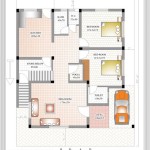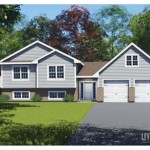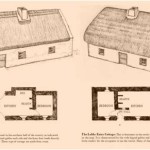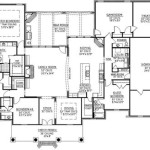Essential Aspects of a House With an Open Floor Plan
Modern home design embraces open floor plans, offering seamless transitions between living areas. These plans create a sense of spaciousness, foster natural light, and enhance social interaction. Understanding the key elements of an open floor plan is crucial for homeowners seeking a functional and cohesive living environment.
Defining Features
Open floor plans are characterized by their fluid layouts, eliminating traditional walls and barriers between living areas such as the living room, dining room, and kitchen. This integrated design allows for a continuous flow of space and light, creating a more spacious and welcoming ambiance.
Advantages of Open Floor Plans
Enhanced Natural Light: Removing walls allows ample natural light to penetrate all living areas, reducing the need for artificial lighting during the day. Greater Spaciousness: The absence of physical barriers creates an illusion of increased space, making homes feel more expansive and airy. Improved Social Interaction: Open floor plans facilitate seamless communication and interaction between family members or guests, fostering a stronger sense of togetherness. Increased Flexibility: The flexible nature of these plans allows for easy reconfiguration as needs change over time, accommodating different furniture arrangements and lifestyle preferences.Design Considerations
Defined Zones: While open floor plans prioritize flow, it's essential to define distinct zones for specific activities. This can be achieved through subtle dividers like furniture, area rugs, or changes in flooring materials. Vertical Elements: Incorporating high ceilings or architectural features like pillars or beams can break the monotony of a large open space, adding visual interest and creating a sense of separation without compromising the flow. Natural Flow: Ensure the layout allows for a natural and logical progression of movement between living areas. Avoid creating dead ends or awkward transitions that disrupt the overall flow. Focal Points: Draw attention to focal points such as a fireplace, a large window, or a piece of statement furniture. This helps create visual anchors and adds character to the space.Challenges and Solutions
Noise Control: Open floor plans can amplify noise, making it difficult to find privacy or focus. Consider using soft furnishings, sound-absorbing materials, or strategic furniture placement to mitigate noise transfer. Clutter Control: With fewer visual barriers, open floor plans require meticulous clutter control to maintain a spacious and organized aesthetic. Implement ample storage solutions and establish designated areas for keeping belongings. HVAC Efficiency: Zoning HVAC systems can ensure optimal temperature control in different areas of the open floor plan, preventing uneven heating or cooling.Conclusion
Open floor plans offer a range of advantages that make them highly desirable in modern home design. By understanding the defining features, benefits, design considerations, and potential challenges, homeowners can create a functional and cohesive open floor plan that enhances their daily living experience. Embracing the principles of openness, flexibility, and smart design ensures a home that is both spacious and inviting, fostering a sense of community and well-being.
Modern Open Floor House Plans Blog Eplans Com

Pros And Cons Of An Open Concept Floor Plan Generation Homes Nw
:max_bytes(150000):strip_icc()/1660-Union-Church-Rd-Watkinsville-Ga-Real-Estate-Photography-Mouve-Media-Web-9-77b64e3a6fde4361833f0234ba491e29.jpg?strip=all)
18 Open Floor House Plans Built For Entertaining

Considerations For Choosing An Open Concept Vs Traditional Floorplan

Open Floor Plans Build A Home With Smart Layout Blog Dreamhomesource Com

House Design Trends What S Popular In Cur Floor Plans Extra Space Storage

Pros And Cons Of Open Concept Floor Plans

Open Floor Plan Concept Plans House The Designers

30 Gorgeous Open Floor Plan Ideas How To Design Concept Spaces

Reasons You Might Want To Avoid An Open Floor Plan








